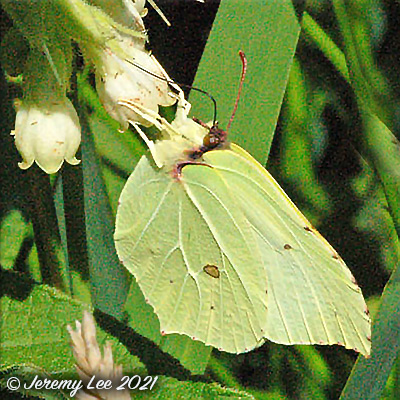
 |
|
Scientific Classifications explained » Amphibians » Ants » Aphids » Bees » Beetles » Birds » Bugs » Butterflies » Caterpillars » Damselflies » Dragonflies » Earwigs » Flies » Frog/Leafhoppers » Fungi » Galls » Grasshoppers » Harvestmen » Hoverflies » Lacewings » Ladybirds » Leaf Mines » Lichens » Mammals » Millipedes » Mosses » Moths » Sawflies » Slugs » Snails » Spiders » Trees » Wasps » Wild Flowers » Woodlice |
UK Nature > Butterflies > Gonepteryx rhamni

Scientific Name: Gonepteryx rhamni Common Name: Brimstone Gonepteryx rhamni, more commonly known as the Brimstone, is a bright yellow butterfly, often the first butterfly to be seen in spring. Male brimstone butterflies have sulphur-yellow forewings and hindwings with an orange central spot. The female's fore- and hindwings are a delicate yellow or pale green with an orange central spot. Both butterflies have greenish veined underwings. The pupa looks like a curled leaf, the new adults emerging from their chrysalids in July and living until the following July. Adults hibernate over winter in woodlands and emerge on warm spring days. Last year's brimstones are often the first butterflies to be seen in spring. They are most likely to be found in woodland, gardens or meadows, sipping nectar from teasel, knapweed and buddleia. Brimstones are common in most of the UK, and have been spreading in recent years, particularly in northern England. |
|

https://www.uknature.co.uk is a website dedicated to showing the immense diversity of UK nature and wildlife. Our vast range of habitats, from lowland arable to snow covered mountains, from storm-ravaged coastlines to peaceful inland freshwater lakes and rivers, from dry, sandy heaths to deciduous and coniferous forests, all these habitats contribute to the abundance of UK nature. We have wild birds in huge numbers either residing or visiting our shores (597 recorded species as at July 2013) and we must also not forget the humble back garden with its grass lawns, flower beds filled with nectar rich flowers, shrubs and trees, all designed to attract huge numbers of insects such as bees, moths, butterflies and hoverflies; and finally the small ponds which provide safe havens for frogs, toads, newts and even slow worms and grass snakes. www.uknature.co.uk is the showcase for my personal passion, photographing uknature in all its glory. I sincerely hope you all enjoy the fruits of my labours. This site and all images contained therein is © Jeremy Lee 2004 - 2021. All Rights Reserved. Site design by Jeremy Lee. Site development & IT Support by Stuart Lee. |